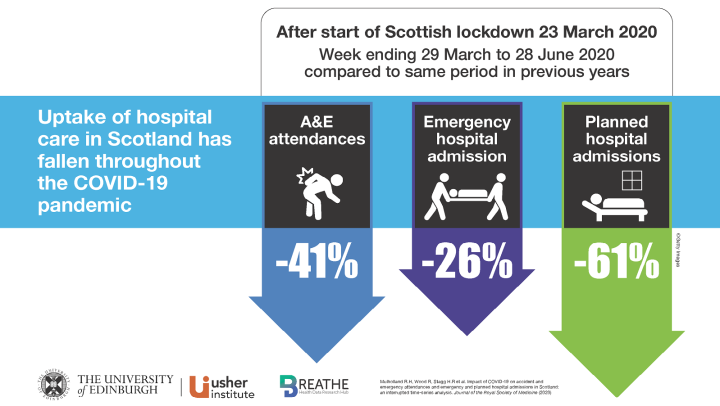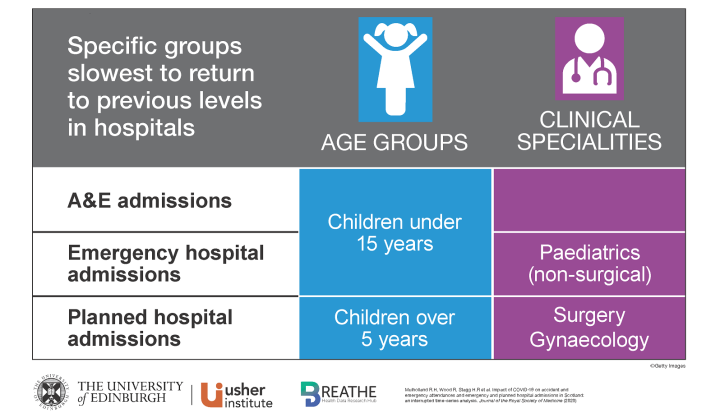Impact of COVID-19 on accident and emergency attendances and admissions in Scotland
October 2020: A study published in the Journal of the Royal Society of Medicine highlights significant drops in A&E attendances, and emergency and planned hospital admissions across Scotland during the first few months of the pandemic.
Impact of COVID-19 on accident and emergency attendances and emergency and planned hospital admissions in Scotland: an interrupted time-series analysis.
Mulholland RH, Wood R, Stagg HR, et al.
Journal of the Royal Society of Medicine. 2020;113(11):444-453.
Available at https://journals.sagepub.com/doi/pdf/10.1177/0141076820962447
This infographic was created by the Usher Institute's Graphic Designer, Dawn Cattanach
Plain English summary
The World Health Organization (WHO) declared a global pandemic of SARS-CoV-2 on 11 March 2020. On 23 March, a UK-wide lockdown was announced. The first wave of COVID-19 reached its peak in early April 2020, causing huge pressures on the National Health Service (NHS).
Epidemic v pandemic: what’s the difference? [BBC News Video]
Why did we carry out this work?
On 17 March 2020, the Scottish Government announced that all non-urgent planned healthcare appointments were to be postponed.
We wanted to capture the impact of COVID-19 on the Scottish healthcare system, for both planned appointments and emergency admissions or attendance. We did this by looking at the effect of the WHO’s pandemic announcement and the first UK lockdown on hospital admissions across Scotland. We studied data from 5 January to 28 June 2020.
We also wanted to see if particular services or groups of people were more or less affected by these changes. We looked at the impact on male and female care, and admissions by age and level of deprivation. We also studied clinical specialities including cancer care, cardiology, accident and emergency (A&E), gynaecology, care for young people (paediatrics) and surgery.
This work should provide a clearer picture of which areas of hospital-based care will need the most attention after COVID-related pressure on the NHS is reduced.
The team carried out the work as part of the Early Pandemic Evaluation and Enhanced Surveillance of COVID-19 (EAVE II) study.
What did we find in this study?

We found two key patterns in this study.
First, there was a dramatic drop in the number of people accessing hospital care overall between 11 and 23 March. Second, it appears that while emergency appointment numbers were returning to pre-pandemic levels by June 2020, the number of planned appointments was still lower than usual.
Compared to the same period in 2018 and 2019, our analysis showed
-
A 41% drop in A&E attendance
-
26% fewer emergency hospital admissions
-
A 61% decrease in planned hospital appointments.
In some cases, including surgery and gynaecology, the number of planned procedures being carried out remained very low by the end of June – at least 50% below normal.
Children under 15 years of age have been particularly affected for both A&E attendance and hospital admissions, with a significant initial drop in numbers and a much slower return to pre-pandemic levels.

What is next?
We predict that the drop witnessed in accessing hospital care over this period is likely to have had an impact on non-COVID-19-related illnesses, increasing the chance of potentially avoidable illness and death.
Further research is needed to investigate the full effects of this disruption, and which services are worst affected as the pandemic develops. We are also expanding our analysis to include all parts of the patient journey, including GP consultations, community care and mental health services.
More information
Read the paper in the Journal of the Royal Society of Medicine
Visit the BREATHE - Health Data Research Hub for Respiratory Health website
Cite as
Mulholland, R. H. et al. (2020) ‘Impact of COVID-19 on accident and emergency attendances and emergency and planned hospital admissions in Scotland: an interrupted time-series analysis’, Journal of the Royal Society of Medicine. doi: 10.1177/0141076820962447.
Note
This plain English summary and infographic were created with the support and feedback of the EAVE II Patient Advisory Group (PAG).


